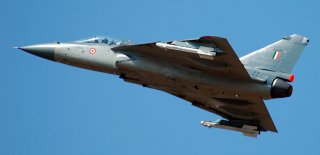Indian Air Force Deployed Indigenous LCA Tejas Fighters to Pakistan Border
And that is history—for a number of reasons.
This week the Indian Air Force deployed its Light Combat Aircraft Tejas on its western border with Pakistan as tensions with China continue to simmer in the Ladakh valley in the east. The Tejas is India's first domestically-produced fighter aircraft, and it has been deployed to forward airbases to reportedly take care of situations along the western and northern fronts.
"The LCA Tejas was deployed by the Indian Air Force on the Pakistan border to thwart any possible misadventure," a government source told India Today.
The Times of India also reported that the first Light Combat Aircraft (LCA) Tejas squadron, 45 Squadron (Flying Daggers) based out of Sulur under the Southern Air Command, was deployed in an operational role to the border region.
This marks a significant milestone for the indigenous fighter aircraft, which has not been without problems during its long development program.
The single-engine, fourth-generation, multi-role light fighter was designed by the Aeronautical Development Agency with collaboration from the Aircraft Research and Design Centre (ARCD) of the Hindustan Aeronautics Limited for the Indian Air Force (IAF) and Indian Navy. Development began in the 1980s as part of the LCA program to replace the aging MiG-21 fighters, but it wasn't until early 2001 that the aircraft took its first flight.
It took another fifteen years, July 2016, for the Tejas to finally enter service with the IAF, while the Indian Navy rejected the aircraft because it weighed too much and produced insufficient thrust for takeoff from the ski-jump ramp of its then in development carrier. Moreover, with a top speed of Mach 1.6 to 1.8, a maximum external load of 7,700 pounds and a service ceiling of fifty-two thousand feet, the Tejas remains unexceptional compared to top-performing fourth-generation light fighters such as the F-16.
To date a total of thirty-three have been produced, but the Indian government has proposed to export the Tejas fighter to Asian nations—highlighting that its simple design and potentially low maintenance cost would be a major selling point.
Despite the problems, Indian prime minister Narendra Modi has praised the aircraft and during an Independence Day speech this year noted that a deal to buy the upgraded Mark1A version of the Tejas could be completed soon. The deal, expected to be worth over Rs 40,000 crore, will likely be the largest-ever deal for an indigenous equipment in the country.
However, the fact that the Tejas has been deployed to the border with Pakistan and not China could be telling. Does this suggest that the IAF has concerns that its fighter couldn't take on China's J-20 fighter jet? In May, during tensions near the India-China Line of Actual Control (LAC), the demarcation line that separates Indian-controlled territory from Chinese-controlled territory in the former princely state of Jammu and Kashmir, the IAF deployed to Russian-built Sukhoi-30MKI jets.
This doesn't build confidence—or likely is a good marketing ploy—for the abilities of the LCA Tejas if it isn't deployed to the LAC.
Peter Suciu is a Michigan-based writer who has contributed to more than four dozen magazines, newspapers and websites. He is the author of several books on military headgear including A Gallery of Military Headdress, which is available on Amazon.com.

